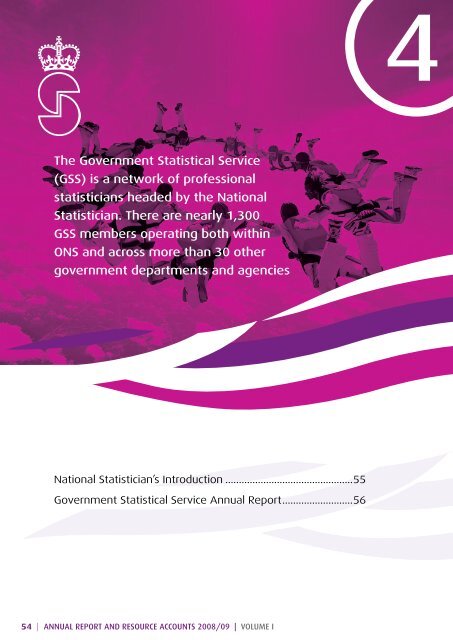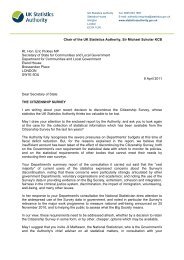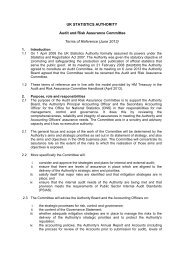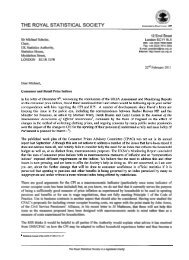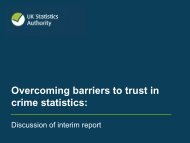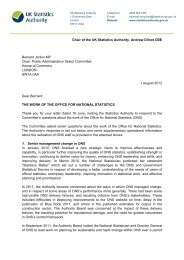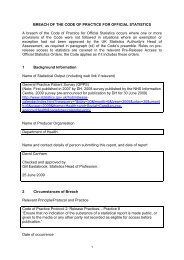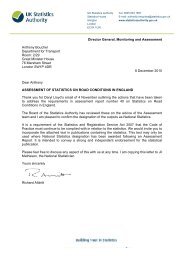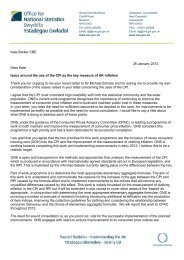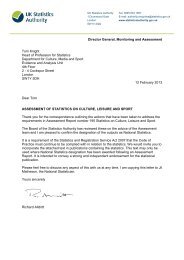The Government Statistical Service - UK Statistics Authority
The Government Statistical Service - UK Statistics Authority
The Government Statistical Service - UK Statistics Authority
You also want an ePaper? Increase the reach of your titles
YUMPU automatically turns print PDFs into web optimized ePapers that Google loves.
4<br />
<strong>The</strong> <strong>Government</strong> <strong>Statistical</strong> <strong>Service</strong><br />
(GSS) is a network of professional<br />
statisticians headed by the National<br />
Statistician. <strong>The</strong>re are nearly 1,300<br />
GSS members operating both within<br />
ONS and across more than 30 other<br />
government departments and agencies<br />
National Statistician’s Introduction ...............................................55<br />
<strong>Government</strong> <strong>Statistical</strong> <strong>Service</strong> Annual Report..........................56<br />
54 | ANNUAL REPORT AND RESOURCE ACCOUNTS 2008/09 | VOLUME I
National Statistician’s<br />
Introduction<br />
Dame Karen Dunnell DCB<br />
This is my last annual report as National<br />
Statistician and my first since the new<br />
independent statistical system came into<br />
effect on 1 April 2008. It details some<br />
of the significant development work<br />
being carried out by statisticians across<br />
the <strong>Government</strong> <strong>Statistical</strong> <strong>Service</strong> (GSS)<br />
and the Northern Ireland <strong>Statistics</strong> and<br />
Research Agency (NISRA) in 2008/09.<br />
One of the main highlights was the first<br />
data-sharing order in February 2009,<br />
allowing data from the School Census to<br />
be shared with ONS. This achievement<br />
demonstrated the utility and effectiveness<br />
of the data-sharing provisions in the<br />
<strong>Statistics</strong> and Registration <strong>Service</strong> Act<br />
2007. Data confidentiality remained a key<br />
priority and data-sharing will only occur<br />
once adequate safeguards to protect any<br />
personal information are in place. I would<br />
like to offer my personal thanks to all<br />
colleagues who have contributed directly<br />
to this milestone.<br />
Data acquired from the first data-sharing<br />
orders will play an important part in the<br />
improvement of migration statistics. This is<br />
one of many partnerships across the GSS<br />
improving methods and sources used for<br />
population estimates.<br />
Preparations for the 2011 Census are<br />
well underway with the main contracts<br />
awarded for data capture and provision<br />
of personnel services. <strong>The</strong> questionnaire<br />
has been developed following a three<br />
year period of extensive consultation<br />
and testing. <strong>The</strong> Scottish rehearsals took<br />
place in March 2009 with rehearsals for<br />
England, Wales and Northern Ireland<br />
to take place in October 2009. An<br />
address register for enumeration has<br />
been developed and tested with 24 local<br />
authorities.<br />
During the past year and in the future<br />
the GSS will continue to experience many<br />
changes. A current project, GSS Leadership<br />
and Revitalisation, is developing many<br />
important strands of work that will lead to<br />
the GSS being an improved, self confident,<br />
and mutually supportive network. This<br />
will prepare the GSS for the challenges<br />
it will face in the future. Early priorities<br />
have focused on data-sharing, statistical<br />
planning and professional standards.<br />
I would like to take this opportunity<br />
to thank everyone in the GSS who has<br />
worked on official statistics during my<br />
time as National Statistician. I will continue<br />
to take an active interest in how the GSS<br />
and the statistical system develops in the<br />
future.<br />
Dame Karen Dunnell DCB<br />
National Statistician and<br />
Head of the GSS<br />
July 2009<br />
Chapter 4 | 55
4<br />
<strong>Government</strong> <strong>Statistical</strong><br />
<strong>Service</strong> Annual Report<br />
<strong>The</strong> GSS Leadership and<br />
Revitalisation Project<br />
Introduction<br />
As the Head of the GSS, the National<br />
Statistician is leading work to build on its<br />
inherent strengths, address the challenges<br />
facing the statistical system, and to<br />
strengthen the working relationship<br />
between the four administrations in the<br />
<strong>UK</strong>.<br />
<strong>The</strong> vision is for a self-confident and<br />
mutually supportive network of people<br />
who provide a coherent package of<br />
services which encompasses high quality<br />
statistics, analysis and advice, and which<br />
meets the needs of decision-makers<br />
inside and outside government.<br />
<strong>The</strong> project’s overall objective is to deliver<br />
the National Statistician’s vision and<br />
objectives for a revitalised GSS. <strong>The</strong> project<br />
is split into two phases with the target<br />
for phase one deliverables being 30 June<br />
2009. Delivery targets for the remainder<br />
of the project will be set after a review of<br />
progress, which is planned to take place<br />
in July 2009. <strong>The</strong> project is split into nine<br />
workstreams which are set out below.<br />
Each will contribute to the achievement of<br />
the National Statistician’s vision. Guidance<br />
and direction is provided by an interdepartmental<br />
GSS Advisory Group.<br />
Progress 2008/09<br />
GSS Professional Community – aims<br />
to strengthen the GSS in terms of its<br />
resources, skills and competences. This<br />
work is carried out mainly through<br />
implementing the work programme<br />
agreed by the GSS Human Resources<br />
Committee (GSS HRC). Current<br />
successes include the commencement of<br />
accreditation boards, the introduction of<br />
a University Liaison Officer scheme and<br />
successful Fast Stream recruitment.<br />
<strong>Statistical</strong> Planning – aims to<br />
produce a government-wide system for<br />
statistical planning that demonstrably<br />
meets user needs. An initial planning<br />
infrastructure has been established and<br />
the GSS <strong>Statistics</strong> Strategy and Planning<br />
Committee has been set up to direct this<br />
work.<br />
Methodology, Standards and Quality<br />
– aims to provide a framework for the<br />
improvement of the methodology,<br />
standards and quality of official statistics,<br />
including their analysis and commentary.<br />
A Quality, Harmonisation and Methods<br />
Tool (QHMT) will be piloted across the<br />
GSS during 2009.<br />
Public Confidence in Official <strong>Statistics</strong><br />
– aims to improve public trust and<br />
confidence in official statistics through<br />
the identification and implementation of<br />
56 | ANNUAL REPORT AND RESOURCE ACCOUNTS 2008/09 | VOLUME I
<strong>The</strong> project’s overall objective is to<br />
deliver the National Statistician’s<br />
vision and objectives for a<br />
revitalised GSS<br />
mechanisms aimed at improving public<br />
perceptions of the statistical service.<br />
Use of <strong>Statistics</strong> – aims to improve the<br />
use of statistics in decision-making and<br />
operational delivery, alongside other<br />
analytical evidence. This workstream<br />
is reviewing the information from the<br />
Departmental Capability Reviews with<br />
the intention of producing case-studies<br />
of departments which make good use of<br />
evidence in policy making.<br />
Data-Sharing – aims to support all parts<br />
of the GSS in exploiting the statistical<br />
potential of administrative data held<br />
elsewhere in government by making<br />
data-sharing a matter of routine and,<br />
where necessary, using the information<br />
sharing provisions in the <strong>Statistics</strong> and<br />
Registration <strong>Service</strong> Act 2007 to create a<br />
legal gateway to facilitate any sharing. In<br />
February 2009 the first data-sharing order<br />
was passed, allowing data for the School<br />
Census to be shared with ONS. Further<br />
progress is detailed later in this chapter.<br />
International – aims to exert real and<br />
lasting influence over international<br />
statistical developments across the<br />
GSS. This is being achieved by the<br />
production of quality briefings for high<br />
level international meetings, by the<br />
development of International Training<br />
Modules and improving compliance<br />
levels for electronic data transfer (via the<br />
e-DAMIS system).<br />
Role of the Heads of Profession<br />
– aims to enhance the position, role,<br />
and influence of statistical Heads<br />
of Profession (HoPs) within the <strong>UK</strong><br />
statistical system. This will be achieved<br />
through the publication of a revamped<br />
edition of the Framework for National<br />
<strong>Statistics</strong> (published in 2000), a new GSS<br />
governance structure, a competency<br />
framework and training module for HoPs,<br />
and updated guidance on the HoP role.<br />
National Statistician’s Guidance –<br />
aims to direct and coordinate the work<br />
of the six GSS task forces that have<br />
been set up to deliver the National<br />
Statistician’s Guidance on Implementing<br />
the <strong>UK</strong> <strong>Statistics</strong> <strong>Authority</strong>’s Code of<br />
Practice for Official <strong>Statistics</strong>. <strong>The</strong> task<br />
forces on – quality methods; statistical<br />
planning; confidentiality; presentation<br />
and publication; use of administrative/<br />
management data and definition of<br />
statistics – will deliver the guidance in<br />
Summer 2009.<br />
Chapter 4 | 57
4<br />
New Governance<br />
Arrangements for the GSS<br />
Background<br />
One key component of the programme<br />
of work designed to reinvigorate the<br />
GSS has been the delivery of a revised<br />
governance structure for the <strong>UK</strong> statistical<br />
system as a whole, to complement that<br />
for the ONS itself. <strong>The</strong>se new governance<br />
arrangements have established a smaller<br />
number of committees with a more<br />
strategic focus and a greater emphasis on<br />
meeting users’ needs.<br />
How We Are Organised<br />
<strong>The</strong> GSS operates on a decentralised<br />
basis. This means that statisticians and<br />
their staff outside ONS work alongside<br />
their policy colleagues within government<br />
departments and across the devolved<br />
administrations. This places a premium on<br />
the need for an overarching governance<br />
structure comprising a set of committees<br />
which can operate on an interdepartmental<br />
and inter-administration<br />
basis, coordinate statistical policy, and<br />
address issues of common concern.<br />
During the year, the National Statistician,<br />
working with colleagues across the<br />
GSS, conducted a thorough review of<br />
the existing committee system with a<br />
view to creating a more streamlined<br />
and flexible structure, able to provide<br />
strategic direction and ensure that the<br />
GSS delivers outputs and services that<br />
offer real value to its users. That review<br />
led to the establishment of the following<br />
committees:<br />
<strong>Statistics</strong> Strategy and Planning<br />
Committee<br />
This Committee is chaired by the National<br />
Statistician, with membership drawn from<br />
the Chief Statisticians in the devolved<br />
administrations, and the senior HoPs for<br />
<strong>Statistics</strong> in departments. Its purpose is<br />
to provide strategic direction to the GSS,<br />
provide high-level advice to the National<br />
Statistician and oversee publication of<br />
a strategic plan. Issues it has discussed<br />
include:<br />
A new system of statistical planning –<br />
the challenge here is how to identify<br />
and prioritise current and future needs<br />
for statistics that meet user needs both<br />
across and within the <strong>UK</strong>. Principles<br />
will be developed and implemented<br />
during 2009<br />
Developing a narrative description<br />
of the <strong>UK</strong> statistical system – the<br />
Committee have commissioned a<br />
number of <strong>The</strong>me Leaders across the<br />
GSS to produce a document that<br />
provides stakeholders with a better<br />
understanding of how the statistical<br />
system works and what it delivers<br />
58 | ANNUAL REPORT AND RESOURCE ACCOUNTS 2008/09 | VOLUME I
Baron Claus<br />
Moser, Head of<br />
the <strong>Government</strong><br />
<strong>Statistical</strong> <strong>Service</strong> at<br />
its creation in 1967,<br />
addresses its 40th<br />
anniversary<br />
Inter-Administration Committee (IAC)<br />
This Committee is chaired by the National<br />
Statistician with membership comprising<br />
the Chief Statisticians in each of the<br />
devolved administrations. Its purpose is<br />
to improve the ways in which the four<br />
nations work together, and to identify the<br />
key inter-administration issues affecting<br />
statistics. Issues discussed to date include:<br />
Concordat on <strong>Statistics</strong> – the IAC<br />
has taken the decision to withdraw<br />
the Concordat on <strong>Statistics</strong> that<br />
underpinned the Memorandum of<br />
Understanding signed by the four<br />
nations at devolution in 1999. A<br />
replacement document outlining best<br />
practice is being developed<br />
<br />
Inter-administration issues – the IAC<br />
has commissioned the GSS to conduct<br />
some research to identify the big<br />
issues affecting statistical production<br />
across the four countries, to inform<br />
strategic planning<br />
A New Planning Infrastructure<br />
A key development over the past year<br />
has been the design of a new planning<br />
infrastructure for the statistical system<br />
which will be able to consider and reflect<br />
users’ views at both the detailed and the<br />
strategic level.<br />
Departments and the devolved<br />
administrations will engage with their<br />
users and plan accordingly. Planning<br />
Groups have been introduced to operate<br />
on an inter-departmental and interadministration<br />
basis, and to replace the<br />
old <strong>The</strong>me Working Groups. <strong>The</strong>y will be<br />
time-bound and analyse and report on<br />
key issues raised by users.<br />
<strong>The</strong>ir findings will be brought together<br />
with the outputs of other planning and<br />
consultation exercises into a consolidated<br />
and prioritised plan, published under the<br />
supervision of the <strong>UK</strong> <strong>Statistics</strong> Strategy<br />
and Planning Committee.<br />
Governance and Planning<br />
Achievements<br />
This Report is not the place to provide<br />
a full account of all the numerous and<br />
wide-ranging programmes, projects and<br />
activities undertaken by the GSS over<br />
the last year and overseen by the new<br />
governance structure described above.<br />
<strong>The</strong> following pages can only provide a<br />
taste of those achievements.<br />
Chapter 4 | 59
4<br />
Data-Sharing and<br />
Making Better Use of<br />
Administrative Data<br />
Introduction<br />
ONS, the Executive Office of the <strong>UK</strong><br />
<strong>Statistics</strong> <strong>Authority</strong> needs to make better<br />
use of administrative data routinely<br />
collected by government and other public<br />
authorities if it is to respond effectively<br />
to changes in society and deal with<br />
the rising costs which are increasingly<br />
affecting traditional methods of collecting<br />
data through surveys and decennial<br />
censuses.<br />
<strong>The</strong>se pressures are recognised in the<br />
<strong>Statistical</strong> Work Programme developed by<br />
ONS where specific projects to produce<br />
new and improved population and<br />
migration statistics, minimise burden<br />
on respondents and reduce compliance<br />
costs, are reliant on securing access to<br />
data from administrative sources.<br />
<strong>The</strong> ongoing relevance of these strategic<br />
drivers has been endorsed, first by the<br />
report of the Treasury Select Committee<br />
on Counting the Population 1 , and more<br />
recently, in the new Code of Practice<br />
for Official <strong>Statistics</strong> 2 where Protocol<br />
Three refers explicitly to the use of<br />
administrative data. Despite these<br />
developments there can be little doubt<br />
that legislation has been the key factor<br />
affecting work during the period under<br />
review. In the past legal barriers have<br />
limited both access to, and use of,<br />
administrative data.<br />
However, the data sharing provisions in<br />
the <strong>Statistics</strong> and Registration <strong>Service</strong><br />
Act 2007 (the Act) have opened up<br />
new opportunities, offering a clear<br />
and consistent basis for making use<br />
of administrative data for statistical<br />
purposes.<br />
Progress to Secure Access to Data<br />
from Administrative Sources<br />
<strong>The</strong> opportunities opened up by the<br />
Act provided the context for much of<br />
the work during 2008/09. In particular,<br />
attention focused on:<br />
developing an agreed programme of<br />
data-sharing work<br />
<br />
securing access to data from priority<br />
sources.<br />
In May 2008 the first of two submissions<br />
was put forward for consideration and<br />
approval by the <strong>UK</strong> <strong>Statistics</strong> <strong>Authority</strong>. This<br />
drew extensively on the priorities identified<br />
by the GSS Subgroup on Data-Sharing for<br />
<strong>Statistical</strong> and Analytical Purposes.<br />
As a result the proposals were designed<br />
to meet specific demands for new and<br />
improved population and migration<br />
60 | ANNUAL REPORT AND RESOURCE ACCOUNTS 2008/09 | VOLUME I
<strong>The</strong> data sharing provisions in the<br />
<strong>Statistics</strong> and Registration <strong>Service</strong><br />
Act 2007 have opened up new<br />
opportunities<br />
statistics, better policy development,<br />
analysis and review as well as more cost<br />
effective collection of data from small<br />
businesses. In brief, six core priorities, three<br />
inflows and three outflows, were identified<br />
and are shown below.<br />
Inflows<br />
Data from the School Census from the<br />
Department for Children, Schools and<br />
Families (DCSF)<br />
Information from the National<br />
Insurance Recording System (Migrant<br />
Workers’ Scan) from HM Revenue and<br />
Customs (HMRC) and the Department<br />
for Work and Pensions (DWP)<br />
Value-Added Tax Data from HMRC<br />
Outflows<br />
Data from the Inter-Departmental<br />
Business Register to the Bank of<br />
England (BoE)<br />
Data from the Inter-Departmental<br />
Business Register to the Department<br />
of Enterprise, Trade and Investment in<br />
Northern Ireland (DETINI)<br />
Key variables from the Labour Force<br />
Survey to DCSF<br />
Having secured approval for these<br />
projects, a second application in<br />
September 2008 extended the work<br />
programme to cover two additional<br />
inflows. Whereas the first, information<br />
on students attending higher education<br />
institutions in England and Wales, is<br />
needed urgently for work on improving<br />
population and migration statistics, the<br />
second, selected data from DWP, will<br />
facilitate work on labour market statistics<br />
as well as wider research and analytical<br />
requirements associated with the<br />
development of the Longitudinal Study.<br />
Having established a clear programme of<br />
work, appropriate project management<br />
and reporting arrangements, good<br />
progress has been made to secure<br />
access to key datasets. ONS completed<br />
negotiations with HMRC and DWP and<br />
made arrangements for the transfer<br />
of selected variables from the National<br />
Insurance Recording System (Migrant<br />
Workers’ Scan) in February 2009.<br />
More recently, the transfer of a sub-set<br />
of variables from the School Census has<br />
been completed. <strong>The</strong> sharing of data<br />
from the School Census necessitated<br />
the development of a detailed statistical<br />
business case as well as the preparation<br />
of draft regulations. <strong>The</strong> latter constituted<br />
the first use of the data-sharing powers<br />
in the Act and were approved following<br />
debates in both Houses of Parliament.<br />
Chapter 4 | 61
4<br />
Access to data from both these high<br />
priority sources will contribute to<br />
the Improving Migration <strong>Statistics</strong><br />
Programme. Furthermore, work on<br />
preparing draft regulations to enable<br />
the <strong>Authority</strong> to share data with the<br />
BoE and DETINI is well advanced. <strong>The</strong><br />
latter will need to be approved by<br />
affirmative resolution in the Northern<br />
Ireland Assembly. Finally, ONS is hoping<br />
to secure approval for access to data<br />
on students attending higher education<br />
institutions in the summer. Once again<br />
this will involve the preparation of draft<br />
regulations.<br />
<strong>The</strong>se positive developments have<br />
demonstrated the utility and effectiveness<br />
of the data-sharing provisions in<br />
the Act. At the same time the work<br />
has underlined the importance of<br />
understanding the scope and content of<br />
individual administrative sources as well<br />
as the need for initial pilot and feasibility<br />
research.<br />
Special attention has had to be given<br />
to dealing with concerns associated<br />
with data security and handling. In all<br />
cases it has been necessary to show that<br />
appropriate measures will be taken to<br />
safeguard confidentiality and comply<br />
with specific legislative or departmental<br />
requirements.<br />
Such issues were the focus of debates in<br />
both Houses of Parliament and underline<br />
the value of the safeguards built into the<br />
Act.<br />
<strong>The</strong> experience that has been gained in<br />
the last year has been invaluable and will<br />
provide a sound basis for taking forward<br />
further data-sharing work. ONS is most<br />
grateful for the help and support received<br />
from officials in DCSF, DWP, HMRC and<br />
the Cabinet Office whose efforts have<br />
contributed directly the progress that has<br />
been achieved.<br />
Census 2011<br />
Introduction<br />
ONS is responsible for the census in<br />
England and Wales. <strong>The</strong> Scottish census<br />
is carried out by the General Register<br />
Office for Scotland (GROS). <strong>The</strong> census<br />
in Northern Ireland is carried out by the<br />
Northern Ireland <strong>Statistics</strong> and Research<br />
Agency (NISRA).<br />
<strong>The</strong> National Statistician and Registrars<br />
General for Scotland and Northern Ireland<br />
continued during the year to facilitate<br />
the harmonisation of the conduct of the<br />
2011 Census. Regular meetings of the <strong>UK</strong><br />
Census Committee were held to review<br />
progress in harmonising a number of key<br />
aspects including:<br />
62 | ANNUAL REPORT AND RESOURCE ACCOUNTS 2008/09 | VOLUME I
the date of the 2011 Census will<br />
be 27 March 2011 throughout the<br />
<strong>UK</strong>, subject to the approval of the<br />
relevant legislatures<br />
the population base will be usual<br />
residents plus visitors<br />
a good degree of harmonisation has<br />
also been achieved on topics and<br />
questions, with agreement on 30 of<br />
the 41 topics across the <strong>UK</strong>. Wording<br />
for approximately 40 of the 50<br />
questions has also been agreed, with<br />
differences arising largely due to the<br />
different context in each country. This<br />
degree of harmonisation of questions<br />
was made possible by the provision of<br />
funding for a fourth page of questions<br />
for individuals in England and Wales.<br />
This funding was provided by each<br />
of the main home government<br />
departments<br />
a common design has been agreed for<br />
census questionnaires<br />
a disclosure control policy has been<br />
agreed by the National Statistician and<br />
Registrars General. Methodological<br />
research will continue in 2009, with a<br />
final decision taken in the autumn<br />
procurement of appropriate systems<br />
and services is driven by the different<br />
needs of the Census Offices. A single<br />
contract with core elements and<br />
<br />
variations for England and Wales and<br />
Northern Ireland was awarded to<br />
Lockheed Martin <strong>UK</strong> Ltd in August<br />
2008 for key operational services.<br />
A separate Scottish contract was<br />
awarded to CACI (<strong>UK</strong>) Ltd in June<br />
2008<br />
a joint statement on output aims<br />
has been agreed by the National<br />
Statistician and Registrars General. A<br />
<strong>UK</strong> output strategy is currently under<br />
development and will be the subject of<br />
wider consultation in autumn 2009<br />
In order to support the process of<br />
harmonisation, the <strong>UK</strong> Harmonisation<br />
Committee with representation from the<br />
<strong>UK</strong> Census Offices was formed in January<br />
2009 and meets on a quarterly basis.<br />
Detailed proposals covering the topics<br />
to be included and the conduct of the<br />
Census in England and Wales are included<br />
Chapter 4 | 63
4<br />
<strong>The</strong> Publication Hub delivers updates<br />
to statistical news releases and at<br />
9.30am, gives a link to all the new<br />
statistical releases that day<br />
in the <strong>UK</strong> <strong>Statistics</strong> <strong>Authority</strong>’s proposals to<br />
Parliament in the White Paper ‘Helping to<br />
shape tomorrow’ published in December<br />
2008. Details of ONS’s work to produce a<br />
high quality enumeration address register<br />
for England and Wales are also included<br />
within the White Paper.<br />
<strong>The</strong> Publication Hub<br />
Introduction<br />
<strong>The</strong> Publication Hub – a platform for<br />
announcing and releasing all National<br />
<strong>Statistics</strong> – was launched in April 2008<br />
to coincide with the commencement of<br />
the <strong>Statistics</strong> and Registration <strong>Service</strong> Act<br />
2007, and to complement the launch<br />
of new ‘About’ sites for both the <strong>UK</strong><br />
<strong>Statistics</strong> <strong>Authority</strong> and the ONS, its<br />
Executive Office.<br />
<strong>The</strong> Publication Hub delivers updates to<br />
statistical news releases and at 9.30am,<br />
gives a link to all the new statistical<br />
releases that day. It is the only website<br />
that provides access to past and present<br />
statistical releases. In addition, users<br />
can access information which tells them<br />
when future statistical releases are going<br />
to be available. Links to the supplying<br />
departments’ own websites are provided<br />
with each statistical release because<br />
the actual releases continue to be held<br />
on departmental websites, along with<br />
underlying sources and datasets.<br />
Guidance on the content and<br />
dissemination of releases is incorporated<br />
in the Code of Practice for Official<br />
<strong>Statistics</strong>. This will be supplemented<br />
by additional guidance provided by<br />
the National Statistician. <strong>The</strong> content<br />
of releases remains the responsibility<br />
of producing departments. GSS Heads<br />
of Profession in each department are<br />
responsible for the professional quality of<br />
outputs released through the Publication<br />
Hub and for approving the publication of<br />
outputs prior to their release.<br />
Progress 2008/09<br />
<strong>The</strong> Publication Hub and the new ‘About’<br />
sites have been delivered as part of the<br />
i-Dissemination Programme within ONS,<br />
working closely with colleagues around<br />
the GSS and with the <strong>UK</strong> <strong>Statistics</strong><br />
<strong>Authority</strong>. That programme also included<br />
making arrangements for the hosting of<br />
these sites.<br />
A full updated version of the Publication<br />
Hub was launched in March 2009. This<br />
new version provided departments<br />
producing statistics from across the GSS,<br />
with direct access to update their release<br />
schedules and catalogue content. It also<br />
introduced a new taxonomy, classifying<br />
all statistical releases to ‘<strong>The</strong>mes’ which<br />
64 | ANNUAL REPORT AND RESOURCE ACCOUNTS 2008/09 | VOLUME I
can be used to browse for data and<br />
information.<br />
As well as continuing to support the<br />
Publication Hub, the focus of development<br />
has now shifted to making necessary<br />
improvements to the dissemination<br />
of output through the ONS website,<br />
particularly making improvements<br />
for finding and accessing data. <strong>The</strong>se<br />
developments will include making<br />
preparations for dissemination of the 2011<br />
Census output and embracing new and<br />
emerging technologies and approaches.<br />
Website links<br />
Publication Hub www.statistics.gov.uk<br />
About the <strong>UK</strong> <strong>Statistics</strong> <strong>Authority</strong><br />
www.statisticsauthority.gov.uk<br />
About ONS www.ons.gov.uk/about<br />
<strong>The</strong> Treasury Committee report on<br />
Counting the Population in 2008<br />
Improving Migration<br />
<strong>Statistics</strong><br />
Introduction<br />
Since the late 1990s migration has<br />
exceeded natural change (the difference<br />
between the number of births and<br />
number of deaths) to become the most<br />
significant driver of population change in<br />
the <strong>UK</strong>. However, it is the most difficult<br />
component to estimate since there is no<br />
definitive source.<br />
Chapter 4 | 65
4<br />
<strong>The</strong> National Statistician has initiated a<br />
large-scale programme of work to build<br />
on the quality of population statistics<br />
(the MSI work programme) and, within<br />
this, is implementing recommendations<br />
made in the interdepartmental Task<br />
Force on Migration <strong>Statistics</strong> in 2006<br />
and the subsequent House of Commons<br />
Treasury Committee report Counting the<br />
Population in 2008.<br />
<strong>The</strong> work programme was set up in April<br />
2008 and involves the GSS working<br />
in partnership across government to<br />
improve methods and sources used in<br />
the production of population estimates.<br />
Key departments involved include<br />
Communities and Local <strong>Government</strong><br />
(DCLG), Department of Health (DH),<br />
Home Office (HO), Department for<br />
Children, Schools and Families (DCSF) and<br />
Department for Universities Innovation<br />
and Skills (DIUS).<br />
<strong>The</strong> improvement work is organised into<br />
five streams:<br />
gaining better information on<br />
migrants as they enter and leave the<br />
country<br />
improving the methods and reliability<br />
of Local <strong>Authority</strong> level population and<br />
migration estimates<br />
<br />
<br />
<br />
using alternative administrative<br />
and survey sources in population<br />
estimation<br />
provision of relevant and timely<br />
analyses and indicators associated with<br />
population<br />
developing a more coherent approach<br />
to the reporting of migration across<br />
government<br />
<strong>The</strong> programme is steered by a senior<br />
cross government programme board, and<br />
has a ministerial group, jointly chaired<br />
by the Minister for Immigration and the<br />
Minister for Local <strong>Government</strong>, to inject<br />
pace and facilitate cross-departmental<br />
working.<br />
Programme Achievements<br />
Entry and Exit data<br />
A series of improvements have been<br />
made to port surveys, including<br />
introducing additional survey shifts at<br />
key ports for the International Passenger<br />
Survey (the main source for international<br />
migration estimates) to provide more<br />
contacts and better coverage of migrants.<br />
From January 2009 a more fundamental<br />
change of emphasis of the survey<br />
towards gathering migration information<br />
was implemented.<br />
ONS have worked in partnership with<br />
the Home Office to ensure that statistical<br />
66 | ANNUAL REPORT AND RESOURCE ACCOUNTS 2008/09 | VOLUME I
A series of improvements have been<br />
made to port surveys, including<br />
introducing additional survey shifts<br />
at key ports for the International<br />
Passenger Survey<br />
requirements of the new e-Borders<br />
system – which has been initiated and<br />
will achieve 95 per cent coverage by the<br />
end of 2010 – will be incorporated into<br />
the programme. This is a major new<br />
initiative that has the potential to provide<br />
a rich source of information on migrants<br />
as they enter or leave the <strong>UK</strong>, leading<br />
to more robust international migration<br />
estimates.<br />
Local Population Estimates<br />
At the end of 2007, the publication of<br />
new estimates of short term migrants at<br />
a high geographic level began – covering<br />
those people staying or leaving for less<br />
than 12 months and filling a gap in the<br />
suite of outputs. Over the course of<br />
the year this continued, along with the<br />
development of a method for supplying<br />
this output at a finer geographic level –<br />
to provide a fuller picture of migration for<br />
local authority areas.<br />
Techniques are also being developed<br />
for improving the measurement of<br />
internal migration (moves within<br />
the <strong>UK</strong>) of students. This is an area<br />
recognised as requiring development<br />
since the standard source for measuring<br />
internal migration (GP registrations)<br />
does not pick up all moves in this age<br />
group. Aggregate data from the Higher<br />
Education <strong>Statistics</strong> Agency containing<br />
term-time address of students in higher<br />
education establishments are being used<br />
to adjust internal migration estimates to<br />
compensate.<br />
Administrative sources provide a timelier<br />
source as the basis for estimating the<br />
geographic distribution of international<br />
migration than the 2001 Census currently<br />
used. <strong>The</strong> GSS has been developing a<br />
model-based approach that combines<br />
several administrative sources to provide<br />
a more representative and current<br />
distribution of international migration at<br />
the local authority level.<br />
Alternative Sources<br />
<strong>The</strong> <strong>Statistics</strong> and Registration <strong>Service</strong><br />
Act 2007 allows the laying of regulations<br />
to permit data-sharing for statistical<br />
purposes between public bodies and<br />
the <strong>UK</strong> <strong>Statistics</strong> <strong>Authority</strong>. One such<br />
regulation was laid early in 2009 to allow<br />
ONS to share the School Census data<br />
owned by the DCSF. This useful source<br />
provides more information on movements<br />
of the school-aged population.<br />
ONS is also sharing Migrant Worker<br />
Scan data (National Insurance Numbers<br />
allocated to foreign workers) owned<br />
by HMRC and DWP, which gives an<br />
indication of international migration<br />
within the economically active<br />
population.<br />
Chapter 4 | 67
4<br />
<strong>The</strong>se two administrative sources have<br />
not been used before in the population<br />
estimates and new methods are being<br />
researched, including record linkage and<br />
statistical modelling, to use them for<br />
counting and distributing migrants. <strong>The</strong>y<br />
are also being used for quality assurance<br />
and validation purposes.<br />
Existing and new survey sources are<br />
also being developed. For example,<br />
establishing the feasibility of a Communal<br />
Establishment Survey that aims to<br />
capture information on migrants living in<br />
communal establishments and otherwise<br />
missed by the household surveys.<br />
Indicators and Analysis<br />
A suite of indicators, drawing upon<br />
information from a number of sources<br />
related to migration numbers and the<br />
impact of migration, is in the process of<br />
development. For example, ONS now<br />
produces churn indicators show how<br />
much population turnover has occurred<br />
in a given area irrespective of net<br />
population change.<br />
<strong>The</strong>se indicators will provide a much<br />
earlier view of migration trends at the<br />
national level, and a means by which the<br />
migration picture can be compared across<br />
local authority areas and across different<br />
sources. Roll-out of this development<br />
started in May 2009.<br />
Migration Reporting<br />
Throughout the year, government<br />
departments that produce statistics<br />
relating to migration have been working<br />
closely together to release such outputs<br />
in a more coherent manner. This includes<br />
the introduction of periodic reporting<br />
on common dates, and joined-up news<br />
releases and briefings.<br />
<strong>Statistical</strong> Contribution to<br />
the National Performance<br />
Framework and Scotland<br />
Performs<br />
Introduction<br />
<strong>The</strong> new Scottish <strong>Government</strong> set out<br />
its vision for Scotland in the Economic<br />
Strategy, which was published in<br />
November 2007 3 . This introduced the<br />
National Performance Framework 4<br />
(NPF). This was a change for the Scottish<br />
<strong>Government</strong> and its analysts as it<br />
represented a move to an outcomesbased<br />
approach.<br />
<strong>The</strong> Scotland Performs 5 website was<br />
launched in June 2008. <strong>The</strong> main aims<br />
are to communicate performance in a<br />
very open and transparent manner, with<br />
the information presented by analysts.<br />
68 | ANNUAL REPORT AND RESOURCE ACCOUNTS 2008/09 | VOLUME I
Techniques are also being developed<br />
for improving the measurement of<br />
internal migration of students<br />
Objectivity and Analytical<br />
Underpinning<br />
Scottish <strong>Government</strong> ministers have<br />
agreed that, although Scotland Performs<br />
is a ministerial publication, decisions<br />
on all analytical issues concerning the<br />
website should be made by a high level<br />
analytical group, which consists of the<br />
Chief Professional Officers in the Scottish<br />
<strong>Government</strong>. This group is currently<br />
chaired by the Chief Statistician in<br />
Scotland.<br />
To support analytical groups, statisticians<br />
in the Scottish <strong>Government</strong> are involved<br />
in the updating and maintenance of the<br />
Scotland Performs website, to ensure it<br />
maintains objectivity and rigour.<br />
Links to local outcomes<br />
<strong>The</strong> National Performance Framework<br />
also has a local dimension, with each of<br />
the local authorities in Scotland compiling<br />
a Single Outcome Agreement (SOA).<br />
<strong>The</strong> SOAs outline each local authority’s<br />
desired local outcomes, and how by<br />
delivering these they will contribute to<br />
the national outcomes.<br />
<strong>The</strong> <strong>Statistics</strong> group, in partnership with<br />
other analysts in the Scottish <strong>Government</strong>,<br />
has worked over the past year to provide<br />
support to local authorities in the<br />
production of their SOAs.<br />
Accessibility<br />
Each indicator page on Scotland Performs<br />
links to a technical note which explains<br />
where the data come from, definitions,<br />
what the baseline figure is, background<br />
methodology and where further<br />
information and publications can be<br />
found.<br />
To further improve access to the<br />
underlying data, Scottish Neighbourhood<br />
<strong>Statistics</strong> 6 includes special reports<br />
for the national indicators at their<br />
available geographies, as well many of<br />
the indicators used commonly across<br />
SOAs. This allows the national and local<br />
indicators to be considered in the context<br />
of other information about the data.<br />
Notes – Chapter 4<br />
1 House of Commons Treasury Select<br />
Committee, Counting the Population,<br />
Eleventh Report of Session 2007/08,<br />
May 2008.<br />
2 Code of Practice for Official <strong>Statistics</strong>,<br />
<strong>UK</strong> <strong>Statistics</strong> <strong>Authority</strong>, January 2009.<br />
3 www.scotland.gov.uk/<br />
Publications/2007/11/12115041/0<br />
4 www.scotland.gov.uk/<br />
Publications/2007/11/13092240/9<br />
5 www.scotlandperforms.com<br />
6 www.sns.gov.uk<br />
Chapter 4 | 69


